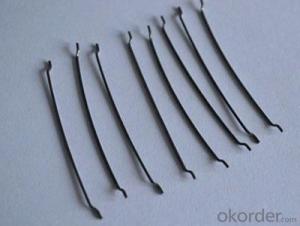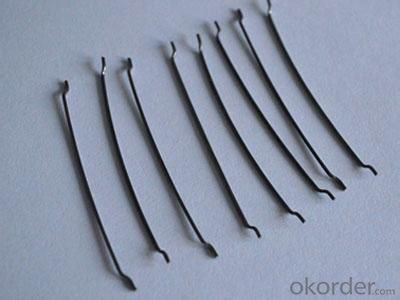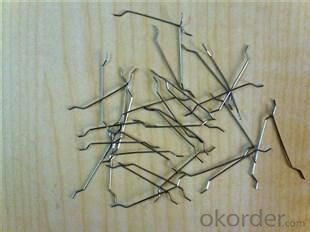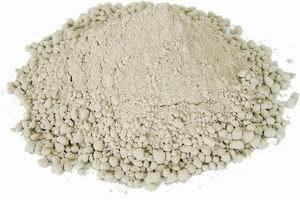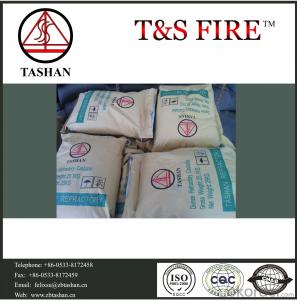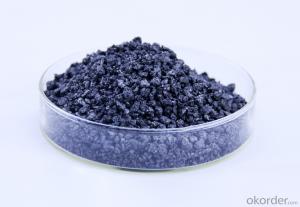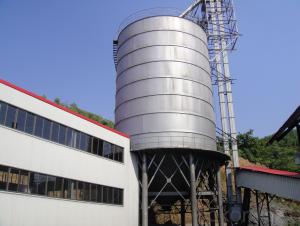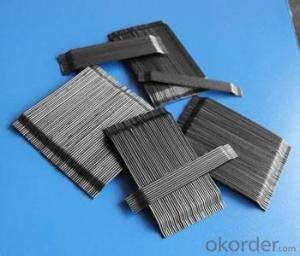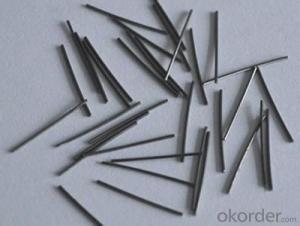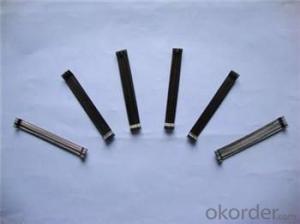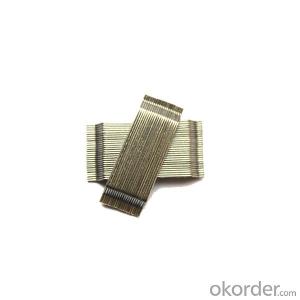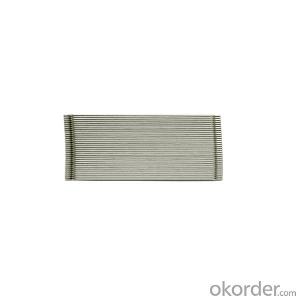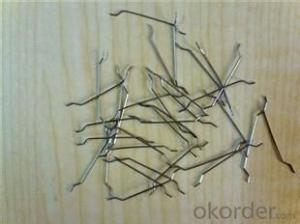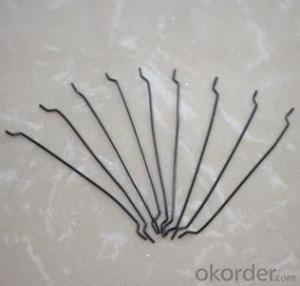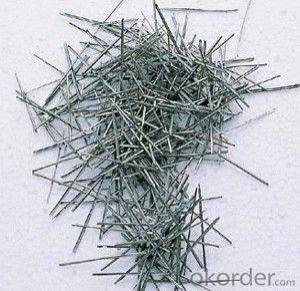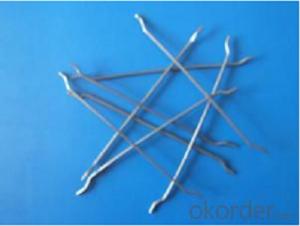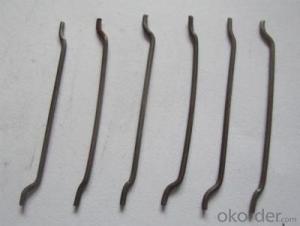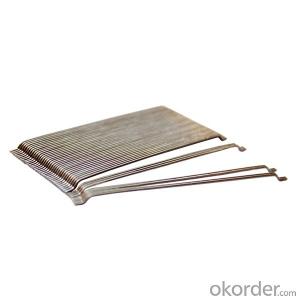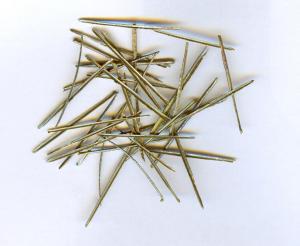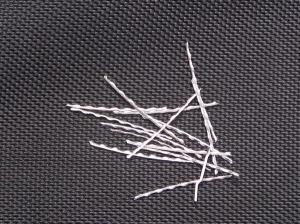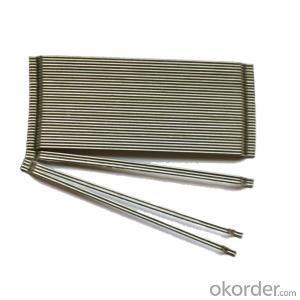Melt Extract Stainless Steel Fiber 0.55/30 Concrete Steel Fiber from CNBM China
- Loading Port:
- Tianjin
- Payment Terms:
- TT OR LC
- Min Order Qty:
- 1 m.t.
- Supply Capability:
- 5000 m.t./month
OKorder Service Pledge
Quality Product, Order Online Tracking, Timely Delivery
OKorder Financial Service
Credit Rating, Credit Services, Credit Purchasing
You Might Also Like
Quick Details
Place of Origin: Tianjin, China (Mainland)
Brand Name: Hengfeng
Model Number: 0.55
Material: Steel
Production Process: Cold drawn
Lengh: 30
Type: 1
Compressive Strength: >1200MPa
Aspect ratio: 55
Standard: ASTM A820M-11
Section Shape: Circular
Application: Concrete Reinforcement
Producing Area: Tianjin
Packaging & Delivery
| Packaging Details: | 20 kg/Bag,50 bags/Pallet or 1,000kg/ Bulk Bag |
|---|---|
| Delivery Detail: | 1 Month |
Product Description
| Diameter | 0.55 | mm | 0.02 | in |
| Length | 30.00 | mm | 1.18 | in |
| Aspect Ratio | 55 | |||
| Tensile strength | 1200 MPa | |||
| Type | Cold drawn Steel Fiber | |||
| End | Hooked-end Steel Fiber | |||
| Glued/Loose | Glued Steel Fiber | |||
| Bending Angle | 45°(min.30°) | |||
| Usage & Performance | Floor:Trafficked areas and Industrial floors | |||
| Shotcrete :Slope stabilization and Final lining | ||||
| Precast concrete:Pipe and Railway sleepers | ||||
| Packing | Standard Export Pallet Packing | Bag Packing | 20 kg/Bag,50 bags/Pallet | |
| Bulk Packing | 1,000kg/ Bulk Bag | |||
| Loading Quantity | 20’GP | 20-25 Tonne/Tonnes | ||
| 40’GP | 25-27 Tonne/Tonnes | |||
| 40’HQ | 25-27 Tonne/Tonnes | |||
| MOQ | 1 kg for trial order | |||
| Supply Ability | 10,000 Tonne/Tonnes per Year | |||
| Payment Terms | T/T or L/C at sight | |||
| Delivery Time | Within 15 days after receiving deposit or original L/C at sight | |||
| Certification | ISO9001:2000, CE, | |||
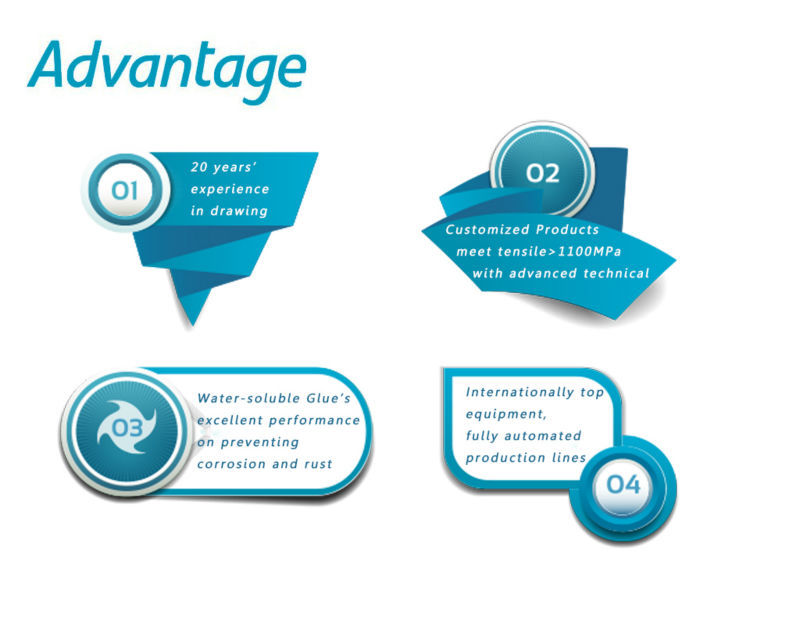
| Product | Diameter | Length mm/in | Aspect Ratio | Type | Packing |
| G-6030 | 0.5 mm (0.0197 in) | 30 mm (1.1811 in) | 60 | Glued | 20 kg/Bag, or 1,000kg/ Bulk Bag |
| G-6535 | 0.55 mm (0.0217 in) | 35 mm (1.3780 in) | 65 | Glued | 20 kg/Bag, or 1,000kg/ Bulk Bag |
| G-6035 | 0.6 mm (0.0236 in) | 35 mm (1.3780 in) | 60 | Glued | 20 kg/Bag, or 1,000kg/ Bulk Bag |
| G-8060 | 0.75 mm (0.0295 in) | 60 mm (2.3622 in) | 80 | Glued | 20 kg/Bag, 50 bags/Pallet |
| G-6060 | 0.9 mm (0.0354 in) | 60 mm (2.3622 in) | 60 | Glued | 20 kg/Bag, 50 bags/Pallet |
| G-6030 | 0.5 mm (0.0197 in) | 30 mm (1.1811 in) | 60 | Loose | 20 kg/Bag, or 1,000kg/ Bulk Bag |
| G-6535 | 0.55 mm (0.0217 in) | 35 mm (1.3780 in) | 65 | Loose | 20 kg/Bag, or 1,000kg/ Bulk Bag |
| G-6035 | 0.6 mm (0.0236 in) | 35 mm (1.3780 in) | 60 | Loose | 20 kg/Bag, or 1,000kg/ Bulk Bag |
| G-8060 | 0.75 mm (0.0295 in) | 60 mm (2.3622 in) | 80 | Loose | 20 kg/Bag, 50 bags/Pallet |
| G-6060 | 0.9 mm (0.0354 in) | 60 mm (2.3622 in) | 60 | Loose | 20 kg/Bag, 50 bags/Pallet |
- Q: Can melt extract stainless steel fiber enhance the flexural strength of concrete?
- Indeed, the incorporation of melt extract stainless steel fibers can increase the flexural strength of concrete. By adding these fibers, one can enhance the tensile and flexural properties of the material, thereby reducing cracks and improving its durability. Melt extract stainless steel fibers offer several advantages over other types of fibers. They are produced through the melting of stainless steel, ensuring their high tensile strength and resistance to corrosion. Consequently, they can be utilized for various applications, including concrete reinforcement. When melt extract stainless steel fibers are introduced to concrete, they create a three-dimensional support network that enhances the material's flexural strength. Additionally, they enhance the bond between the concrete matrix and the fibers, lowering the risk of failure when exposed to bending or flexural loads. Moreover, the inclusion of melt extract stainless steel fibers in concrete also bolsters its resistance to cracking. These fibers act as bridges across cracks, impeding their propagation and ultimately resulting in increased toughness and durability. Consequently, this makes the concrete more suitable for structural applications that require heightened flexural strength. Furthermore, melt extract stainless steel fibers can enhance the impact resistance of concrete. Their presence enables the absorption and distribution of impact energy, mitigating the likelihood of sudden failure or breakage. In conclusion, melt extract stainless steel fibers are an effective means of enhancing the flexural strength of concrete. By augmenting the material's tensile and flexural properties, they reduce cracking and improve its overall durability. As a result, these fibers serve as a reliable and efficient reinforcement option for concrete structures that necessitate increased flexural strength, as well as improved resistance to cracking and impact.
- Q: How does melt extract stainless steel fiber affect the crack width of concrete?
- Melt extract stainless steel fiber has a significant effect in reducing crack width in concrete. When incorporated into the concrete mix, these fibers act as reinforcement, enhancing the overall strength and durability of the material. The fibers are evenly distributed within the concrete matrix, forming a three-dimensional network that helps control cracking. The primary way in which melt extract stainless steel fibers reduce crack width is by preventing crack propagation. As concrete shrinks and undergoes thermal expansion and contraction, small cracks may form. However, the presence of stainless steel fibers acts as a barrier, preventing the cracks from enlarging and spreading throughout the concrete. Furthermore, the unique properties of stainless steel contribute to its effectiveness in reducing crack width. Stainless steel fibers have high tensile strength, allowing them to withstand significant loads and resist deformation. This strength enables the fibers to bridge cracks, providing additional reinforcement to the concrete and preventing further crack propagation. The aspect ratio of the fibers, or the ratio of their length to diameter, also plays a role in controlling crack width. Longer fibers tend to be more effective in limiting crack propagation compared to shorter fibers. Therefore, selecting the appropriate aspect ratio of melt extract stainless steel fibers is crucial in achieving the desired crack control in concrete. In conclusion, melt extract stainless steel fibers have a positive impact on crack width in concrete by minimizing crack propagation. Through their reinforcement properties and ability to bridge cracks, these fibers enhance the overall structural integrity of concrete, resulting in reduced crack width and improved durability.
- Q: How does melt extract stainless steel fiber affect the modulus of elasticity of concrete?
- By incorporating melt extract stainless steel fiber into concrete, a significant impact can be observed on the modulus of elasticity. These fibers, when introduced to the concrete mixture, boost the overall strength and stiffness of the material. The superior tensile strength and rigidity of stainless steel fibers aid in the uniform distribution of stress throughout the concrete matrix. Consequently, this leads to an improvement in the load-bearing capacity of the concrete and a reduction in cracking. The addition of melt extract stainless steel fiber reinforces the concrete by increasing its modulus of elasticity and bridging any possible microcracks. Consequently, the propagation of cracks is prevented, ultimately enhancing the durability and structural integrity of the concrete. Furthermore, the stainless steel fibers function as a reinforcement mechanism, ensuring the concrete's integrity even under extreme conditions like high temperatures or dynamic loading. The elevated modulus of elasticity provided by these fibers enables the concrete to better withstand external forces and deformations, thereby minimizing the risk of failure. To summarize, the inclusion of melt extract stainless steel fiber has a positive influence on the modulus of elasticity of concrete. This is achieved by strengthening the material, improving its load-bearing capacity, reducing cracking, and enhancing its resistance to various environmental and mechanical stresses.
- Q: Is melt extract stainless steel fiber suitable for use in high-performance mortar?
- Yes, melt extract stainless steel fiber is suitable for use in high-performance mortar. Stainless steel fibers are known for their exceptional strength, durability, and corrosion resistance, making them ideal for applications that require high-performance materials. When added to mortar, these fibers can enhance the overall performance of the mortar by improving its tensile and flexural strength, reducing cracking, increasing impact resistance, and enhancing durability. Additionally, melt extract stainless steel fibers have a high melting point, which allows them to withstand high temperatures without losing their mechanical properties. This makes them particularly suitable for high-performance applications where the mortar will be exposed to extreme conditions or thermal stresses. Overall, melt extract stainless steel fiber can significantly improve the performance and lifespan of high-performance mortar.
- Q: Can melt extract stainless steel fiber be used in precast concrete elements?
- Yes, melt extract stainless steel fiber can be used in precast concrete elements. It enhances the strength and durability of the concrete, improves crack resistance, and provides better resistance to corrosion.
- Q: What is the recommended testing procedure for melt extract stainless steel fiber in concrete?
- The recommended testing procedure for melt extract stainless steel fiber in concrete involves the following steps: 1. Sample preparation: Prepare a representative sample of the concrete mixture containing the melt extract stainless steel fiber. Ensure that the fiber content in the sample is consistent with the desired fiber dosage in the actual concrete application. 2. Mixing: Thoroughly mix the sample to ensure uniform distribution of the stainless steel fibers throughout the concrete mixture. This can be done using a concrete mixer or by hand mixing. 3. Casting: Pour the mixed concrete into the desired mold or testing apparatus. Ensure that the mold is properly prepared and cleaned to prevent any interference with the test results. 4. Curing: Allow the concrete specimen to cure for a specified period of time under controlled conditions. This typically involves maintaining a consistent temperature and humidity level to promote proper hydration and strength development. 5. Testing: Once the concrete has sufficiently cured, perform the necessary tests to evaluate the performance of the melt extract stainless steel fiber in the concrete. Common tests include compressive strength, flexural strength, and toughness tests. 6. Data analysis: Analyze the test results to determine the effectiveness of the melt extract stainless steel fiber in enhancing the concrete's mechanical properties. Compare the results to those of a control group without the fiber reinforcement to assess the fiber's impact on the concrete's performance. 7. Reporting: Document the testing procedures, results, and any relevant observations in a comprehensive report. Include details such as fiber dosage, curing conditions, and test methodologies to ensure reproducibility. It is important to note that the specific testing procedure may vary depending on the intended application and the requirements of the project. Consulting relevant standards, guidelines, or industry best practices can provide more specific recommendations for testing melt extract stainless steel fiber in concrete.
- Q: Can melt extract stainless steel fiber be used in tunnel segmental lining?
- Yes, melt extract stainless steel fiber can be used in tunnel segmental lining. The use of stainless steel fiber in tunnel segmental lining offers several advantages. Firstly, stainless steel fibers provide enhanced tensile strength and durability to the tunnel lining, which is crucial for ensuring the structural integrity and longevity of the tunnel. Secondly, stainless steel fibers offer excellent resistance to corrosion, making them ideal for use in underground environments where exposure to moisture and chemicals is common. Additionally, the use of stainless steel fibers can help to reduce cracking and improve the overall performance of the tunnel lining by enhancing its resistance to shrinkage, thermal expansion, and other potential deformations. Therefore, melt extract stainless steel fiber is a suitable choice for tunnel segmental lining applications.
- Q: Can melt extract stainless steel fiber be easily dispersed in concrete mixtures?
- Yes, melt extract stainless steel fiber can be easily dispersed in concrete mixtures. The fine and uniform nature of these fibers allows for easier mixing and distribution within the concrete matrix. Additionally, the high aspect ratio of the fibers enhances their ability to interlock with the concrete, thereby improving its mechanical properties such as tensile strength and crack resistance. The integration of melt extract stainless steel fibers in concrete mixtures can effectively enhance the overall performance and durability of the concrete.
- Q: Can melt extract stainless steel fiber be used in nuclear power plant construction?
- Yes, melt extract stainless steel fiber can be used in nuclear power plant construction. These fibers possess high temperature resistance and excellent mechanical properties, making them suitable for applications in nuclear power plants where durability and strength are crucial. Additionally, they offer resistance to corrosion and radiation, which are important considerations in such environments.
- Q: Can melt extract stainless steel fiber be used in high-performance concrete?
- Certainly, high-performance concrete can indeed utilize melt extract stainless steel fiber. Commonly employed as reinforcement, stainless steel fibers enhance the mechanical properties and durability of concrete. These specific fibers are produced by melting stainless steel and then drawing it into fine strands. Generally, a small quantity of these fibers is added to concrete mixes to enhance tensile strength, flexural strength, and resistance to cracking. The utilization of melt extract stainless steel fibers in high-performance concrete can significantly enhance its performance. Functioning as reinforcement, these fibers provide additional strength while impeding crack propagation. This is particularly vital for high-performance concrete, which aims to possess superior mechanical properties and resilience to harsh conditions. The incorporation of melt extract stainless steel fibers can optimize the concrete's ability to withstand impact, fatigue, and fire. It also aids in diminishing shrinkage and cracking, thereby extending the lifespan of concrete structures. Furthermore, stainless steel fibers possess corrosion resistance, which proves highly advantageous in environments where the concrete encounters aggressive chemicals or moisture. In summary, melt extract stainless steel fiber serves as a suitable and effective reinforcement material for high-performance concrete. It elevates the concrete's mechanical properties, durability, and resistance to cracking, subsequently enhancing the overall performance of the concrete structure.
Send your message to us
Melt Extract Stainless Steel Fiber 0.55/30 Concrete Steel Fiber from CNBM China
- Loading Port:
- Tianjin
- Payment Terms:
- TT OR LC
- Min Order Qty:
- 1 m.t.
- Supply Capability:
- 5000 m.t./month
OKorder Service Pledge
Quality Product, Order Online Tracking, Timely Delivery
OKorder Financial Service
Credit Rating, Credit Services, Credit Purchasing
Similar products
Hot products
Hot Searches
Related keywords
